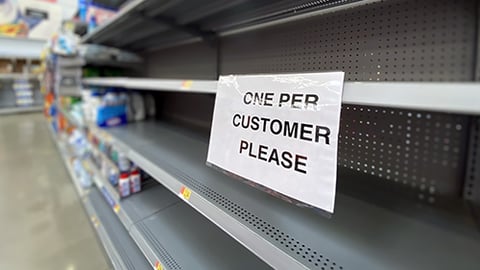Homebound Consumers Spur CPG Spending Increase
Stay-at-home orders implemented across the United States amid the coronavirus pandemic have fed higher demand for consumer packaged goods (CPGs), according to an economic indicator released by the Consumer Brands Association (CBA). The industry saw 9.9 percent year-over-year growth during May of this year, compared with May 2019.
“The CPG industry is doing everything in its power to meet skyrocketing demand at a time that Americans are relying on our products more than ever,” noted Geoff Freeman, president and CEO of Arlington, Virginia-based CBA.
A recent CBA poll found that nearly nine in 10 (87% of) respondents said that their trust in the CPG industry has grown or remained steady as a consequence of how it has responded to the pandemic, mainly on how it has consistently provided high-quality products and how it has treated employees.
CBA’s inaugural CPG Economic Pulse examines the performance of the overall industry, encompassing food and beverage, household cleaning and personal care products. The report will come out monthly.
The most recent results, from this past May, showed an increase in CPG purchases of 4.1% over April. After massive panic buying in March that drove CPG purchases up 21.1% year over year, April and May saw some stabilization, although purchases were still considerably higher than before the pandemic. The May increase, caused by the need to replenish March stocks, indicates that higher demand should be expected during the COVID-19 recovery period, according to CBA.
“We anticipate elevated demand throughout the pandemic — and even beyond, we could see increased at-home consumption as part of a changed world,” observed Freeman. “The CPG industry has always adapted and will continue to evolve to meet the needs of consumers.”
The vigorous pace of production for CPG companies contrasts with a faltering economy. Payrolls have rebounded with 7.5 million jobs, according to June’s better-than-expected employment numbers but recovering the 22 million jobs lost in March and April will be a long-term challenge for the labor market. Consequently, many Americans are receiving federal unemployment benefits, a portion of which are being spent CPG necessities: 86% of U.S. Census survey respondents said they were using at least some of their stimulus benefits to purchase food, with another 58% said they were using it for household or personal care items.
To help the industry meet consumer demand, CBA recently put out 10 critical policy changes, among them improving the hours-of-service rule for truck drivers to boost the flow of essential consumer goods, expediting review of product claims so consumers know which cleaning and sanitizing products prevent COVID-19, and maintaining food labeling flexibility so restaurant products can quickly be redirected to grocery stores when consumer demand surges.






